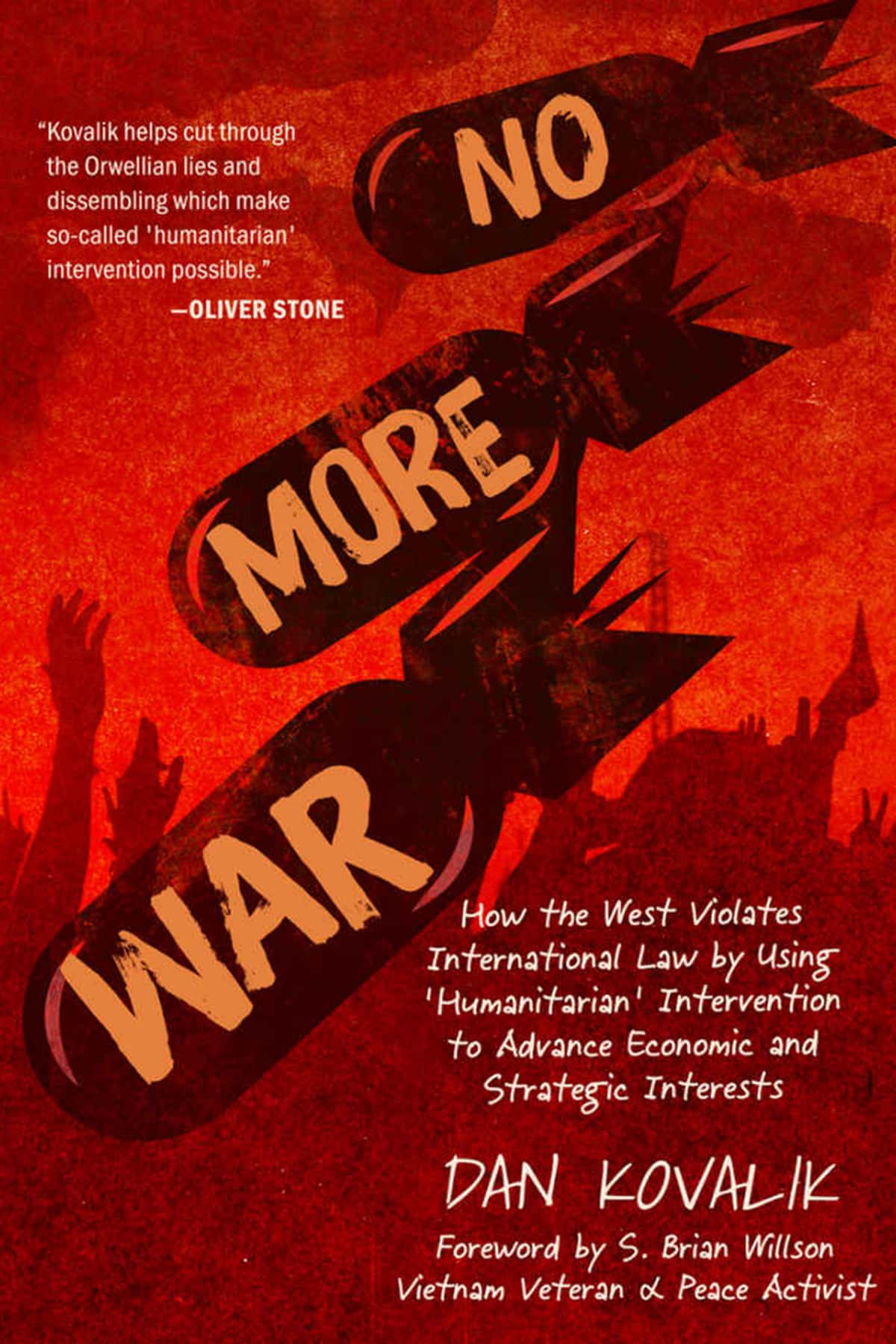
The United States expands its empire with two excuses for war. One is to ”spread democracy” and the other is for “humanitarian intervention.” Both are bogus. No More War is all about humanitarian interventionism. In every case since World War II, the receiving country would have been far better off if the USA had not intervened at all.
Dan Kovalik’s new book, No More War: How the West Violates International Law by Using “Humanitarian” Intervention to Advance Economic and Strategic Interests makes a powerful case that humanitarian war no more exists than philanthropic child abuse or benevolent torture. I am not sure the actual motivations of wars are limited to economic and strategic interests — which seems to forget the insane, power-mad, and sadistic motivations — but I am sure that no humanitarian war has ever benefitted humanity.
The book does not take the approach so widely recommended of watering down the truth so that the reader is only gently nudged in the right direction from where he or she is starting. There is no getting 90% reassuringly wrong in order to make the 10% palatable here. This is a book for either people who have some general notion of what war is or people who aren’t traumatized by jumping into an unfamiliar perspective and thinking about it.
Kovalik traces the history of “humanitarian” war propaganda back to King Leopold’s mass killing and enslavement of the people of the Congo, sold to the world as a benevolent service — a nonsensical claim that found great support in the United States.
In fact, Kovalik rejects Adam Hochschild’s assertion that the activism that opposed Leopold led eventually to today’s human rights groups. As Kovalik documents extensively, organizations like Human Rights Watch and Amnesty International in recent decades have been strong supporters of imperialist wars, not opponents of them.
The message devotes a great deal of space to documenting exactly how overwhelmingly and redundantly illegal war is, and how impossible it is to legalize a war by calling it humanitarian. Kovalik examines the United Nations Charter — what it says and what governments claim it says, as well as the Universal Declaration of Human Rights, the 1968 Proclamation of Teheran, the 1993 Vienna Declaration, the International Covenant on Civil and Political Rights, the Genocide Convention, and numerous other laws that forbid war and — for that matter — sanctions of the sort the U.S. often uses against nations it is targeting for war.
Kovalik draws numerous key precedents from the ruling of the International Court of Justice in the 1986 case of Nicaragua vs. the United States. The accounts that Kovalik offers of particular wars, such as Rwanda, are well worth the price of the book. The book concludes by recommending that someone who cares about human rights make the greatest possible contribution to that cause by working to prevent the next U.S. war. I couldn’t agree more.
Brian Willson’s foreword to the book dismisses the Kellogg-Briand Pact as “terribly flawed because political leaders continually justified exemptions incorporated into the self-defense provisions of the Treaty.” This is an unfortunate claim for many reasons, first and foremost because the self-defense provisions of the Kellogg-Briand Pact do not exist and never did. The treaty includes practically no provisions at all, as the substance of the thing consists of two sentences.
This misunderstanding is a sad one, because the people who drafted and agitated and lobbied to create the Pact adamantly and successfully took a stand against any distinction between aggressive and defensive war, intentionally seeking to ban all war, and endlessly pointing out that allowing claims of self-defense would open the floodgates to endless wars. The U.S. Congress added no formal modifications or reservations to the treaty, and passed it exactly as you can read it today. Its two sentences do not contain the offending but mythical “self-defense provisions.” Some day we may manage to take advantage of that fact.
The Senate Foreign Relations Committee at the time, and most people ever since, have simply assumed that no treaty could possibly eliminate the right to “self-defense” through mass killing. But there is a difference between a treaty like the Kellogg-Briand Pact that does something many cannot comprehend and a treaty like the UN Charter that makes common assumptions explicit.
The UN Charter indeed contains self-defense provisions. Kovalik describes how the United States has turned Article 51 of the UN Charter into a weapon, exactly as the activists who created the Kellogg-Briand Pact predicted. But written clean out of Kovalik’s history of where laws came from is the key role played by the Kellogg-Briand Pact in creating the Nuremberg and Tokyo trials, and the key way in which those trials twisted the ban on war into a ban on aggressive war, a crime invented for its prosecution, though perhaps not an ex post facto abuse because this new crime was a subcategory of the crime actually on the books.
Kovalik focuses on the UN Charter, and points out its antiwar provisions, and notes that those that have been ignored and violated still exist. One might say the same about the Pact of Paris, and add that what exists in it lacks the weaknesses of the UN Charter, including the loopholes for “defense” and for UN authorization, and including the veto power bestowed on the biggest weapons dealers and warmongers.
When it comes to the loophole for wars authorized by the UN Security Council, Kovalik writes favorably of a list of criteria that should be met before a war is authorized. First, there must be a serious threat. But that looks to me like preemption, which is little more than an open door to aggression. Second, the purpose of the war must be proper. But that’s unknowable. Third, the war must be a last resort. But, as Kovalik reviews in various examples in this book, that is never the case; in fact it’s not a possible or coherent idea — there is always something other than mass killing that can be tried. Fourth, the war must be proportional. But that’s immeasurable. Fifth, there must be a reasonable chance of success. But we know that wars are far less likely to achieve positive lasting results than are nonviolent actions. These criteria, these vestiges of ancient “just war” theory, are very Western and very imperialistic.
Kovalik quotes Jean Bricmont claiming that “all” the colonialism in the world collapsed during the 20th century “through wars and revolutions.” Were this not so obviously false — were we not aware that laws and nonviolent actions played major roles this claim would present a major question. Why should we have “no more war” if only war can end colonialism? This is why the case for abolishing war benefits from adding something about its replacements.
The case for war abolition is weakened by the frequent use in this book of the word “nearly.” For example: “Nearly every war the U.S. fights is a war of choice, meaning that the U.S. fights because it wants to, not because it must do so in order to defend the homeland.” That last term still strikes me as fascistic, but it is the first word of the sentence I find most disturbing. “Nearly”? Why “nearly”?
Kovalik writes that the only time in the past 75 years in which the U.S. could have made a claim for defensive war was just after September 11, 2001. But Kovalik immediately explains why that is not actually the case at all, meaning that in no cases at all could the U.S. government have accurately made such a claim for one of its wars. Then why add “nearly?”
I am also afraid that opening the book with a selective look at Donald Trump’s rhetoric, and not his actions, in order to depict him as a threat to the war-making establishment could turn off some people who should read this book, and that ending with claims about Tulsi Gabbard’s strength as an antiwar candidate would be already out of date if they would ever made sense.
David Swanson
Hot Books
Originally published on citizentruth.org as Wait, What If War Isn’t Humanitarian?















